Greetings, dear lovers of the garden and garden!
Many summer residents set aside a bed for winter in the garden. Garlic seeds planted in autumn (cloves, cloves or air bulbs) overwinter in the soil to in early spring start growing season. Winter garlic ripens by mid-summer, giving vegetable growers juicy with large teeth.
From correct pre-sowing treatment soil depends on the future crop crop. Based on this, the topic of my article today is preparing beds for winter garlic. Garlic is quite demanding on the fertility of the soil and its physical properties - moisture and water permeability. Growing a decent crop of bulbs in heavy, clayey, rocky, poor in humus and minerals, poorly cultivated soil is almost impossible.
Since garlic does not grow well in soil with high acidity, work should be carried out on it, and it is advisable to apply dolomite flour or fluff lime a year before planting. With a shallow groundwater in the area and in the lowlands, garlic is grown only on high ridges. The place under the culture should be sunny, preferably protected from drafts.
A bed for vegetables is prepared a month before planting. Planting dates depend on climatic conditions and the weather of the current autumn. AT middle lane the culture is planted from the end of September (in cold autumn) to the end of October (in warm weather).
Measures to prepare the beds for winter garlic
First of all, they dig the soil to a depth of a shovel bayonet with the simultaneous application of mineral and organic fertilizers. Fresh manure and bird droppings for garlic are not plowed due to the high content of nitrogen substances in these types of fertilizers.
From organic matter, mature compost or humus is used for culture at the rate of 1-4 buckets for each running meter. The amount of organic matter is regulated depending on the initial indicators of soil fertility on the site.
Of the mineral compositions for winter plantings, phosphorus and potash products are used. Fertilizers with nitrogen are not used before winter sowing, since nitrogen stimulates the intensive growth of the aerial part, and this can lead to freezing of plants. For each square meter 30-40 g of double superphosphate and 10-20 g of potassium sulfate are taken.
Phosphorus-potassium fertilizers can be fully replaced, which contains a whole range of macro- and microelements. Ashes are plowed at the rate of 1-2 cups for each meter of the garden.
Further, the land on the plantation is harrowed and loosened with a rake, and then grooves are cut at a distance of 25-30 cm from each other. The day before planting, the soil in the garden is moistened (if there is precipitation, watering is not required).
Planting garlic and mulching beds
The teeth are planted at a distance of 10-15 cm from each other. The distance between the leaves is 2-3 cm. Deepening planting material depends on 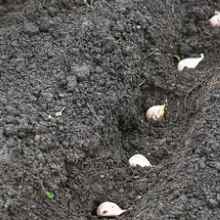 soil type and weather conditions winters in your region. On average, teeth and large single teeth are immersed in the ground by 4-8 cm, and bulbs - by 2-4 cm.
soil type and weather conditions winters in your region. On average, teeth and large single teeth are immersed in the ground by 4-8 cm, and bulbs - by 2-4 cm.
After sowing, the grooves are covered with loose fertile soil and the plantings are mulched with organic matter, for example, with a 3-4 cm layer of compost, humus, and rotten straw. Additionally, you can insulate the beds with spruce or pine spruce branches, which contributes to the retention of snow, creating a kind of “blanket” and enriching the plantings with valuable moisture after the spring thaw. In early spring, after the snow melts, large mulch is removed.
Have a good harvest in the garden and in the garden!
- Hello dear friends! Today's story is about how to store garlic in winter and the timing of harvesting garlic from the beds. The garlic that you planted in the fall (winter) is usually harvested at the end of July -...
- Hello dear friends! Today I will tell you how I cook young pickled garlic in three different ways. Recipe 1. First, I divide the garlic into cloves, pour it hot (50 - 60) ...
- Hello, dear visitors of the site! Today we’ll talk about how to plant garlic, care for it and properly clean it. Garlic is an annual plant that reproduces vegetatively cloves and bulbs...
- Hello dear plant lovers! The topic of this article is "How to plant garlic in the fall." Garlic for planting in the fall is called "winter". Winter varieties of garlic are mostly shooters, but there are also non-shooters. TO...
- Secrets of growing large heads of garlic Good afternoon, dear friends! Any gardener strives to get the most out of his own work. The pride of the vegetable grower is a bountiful harvest of all crops. The popular...
If you plan to grow garlic on your plot, it is best to worry about this in the fall. Landing this bulbous plant before winter will provide excellent quality and large size of heads and cloves of garlic.
It's no secret that the main conditions for a rich harvest winter garlic- in the correct determination of the place for planting and compliance with the technology of preparing the beds. We tell you how to plant garlic in the fall.
Planting dates for winter garlic
When to plant garlic before winter depends primarily on the planned planting depth.
1. Planting garlic before winter to a depth of 3-5 cm
Most often, garlic is deepened by 3-5 cm. In this case, planting is carried out 2-3 weeks before first frost.
In the middle lane, this period usually falls on September 20th - October 10th. In warmer regions with a mild climate, this november.
2. Planting winter garlic to a depth of 10-15 cm
Many gardeners prefer to plant garlic at a greater depth, with this method it takes root better and more easily tolerates winter frosts. When to plant winter garlic with deep planting? In the middle lane - already from the last decade of August to the second decade of October.
How to distinguish winter garlic from spring
Naturally, the main difference is that winter garlic planted before winter, and spring- in the spring.
In addition, they can be distinguished by external signs.
Then you can plant garlic before winter
It is better if they grew in the garden before the garlic tomatoes, cucumbers, legumes . Also good precursors of garlic can be early cabbage, zucchini, pumpkin. In this case, the soil for garlic will be as saturated as possible with organic fertilizers.
In places that were occupied by potatoes or onions, planting garlic is not recommended. This is due to the fact that between these crops there is a high risk of "exchange" of diseases (nematode, fusarium, etc.).
You should also not plant winter garlic in areas where manure was applied this year: garlic will give abundant tops, loose heads and will be less resistant to fungal diseases.
Choosing a place for beds for winter garlic
Find in your area the most fertile soil with normal or low acidity. This is where the garlic should be planted. Make a bed on the sunny side, placing it from north to south.
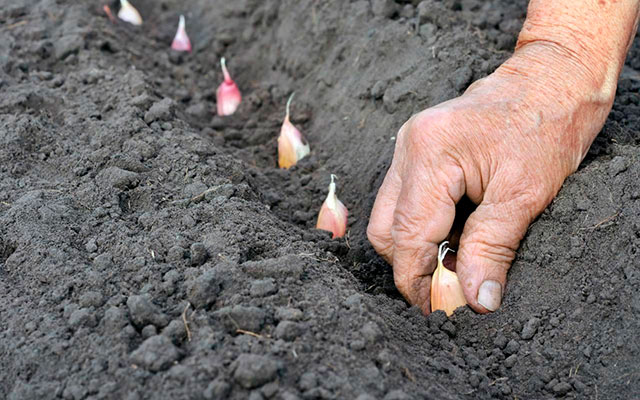
How to prepare a bed for winter garlic?
Preparation for planting winter garlic begins in advance.
1. Prepare the soil for garlic
AT late August - early September it is necessary to fertilize the soil: 10 kg of humus, 1 cup of chalk and 2 cups of ash are added for each square meter of area, 2 tablespoons are added. potassium sulfate and 1 tbsp. superphosphate. Evenly distributing all the components on the soil, it needs to be dug up. The digging depth must be at least 20 cm.
2. We form a bed
An ideal bed for winter garlic will be up to 1 m wide and up to 25 cm high.
3. Give time to shrink the soil
Some gardeners are in a hurry and plant garlic immediately after digging. This affects the growth and development of the plant: garlic cloves, when the soil settles, are deep in the ground, and in the spring, the germination time of the shoots increases and the crop yield decreases.
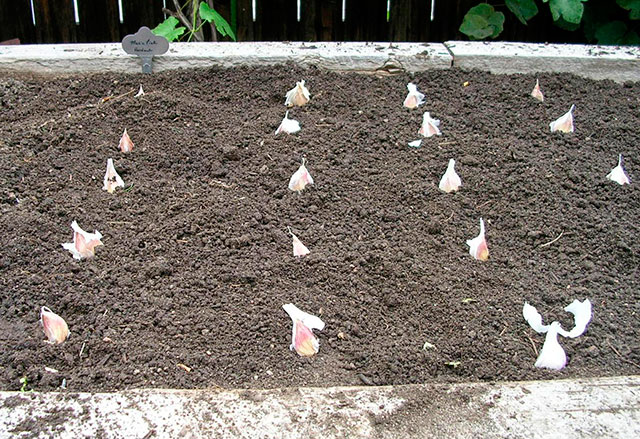
4. We cultivate the soil
In order to prevent garlic diseases, treat the land with a 1% solution blue vitriol(1 tbsp. Dilute the substance in 10 liters of water). With the resulting solution, use a watering can to pour the entire area of \u200b\u200bthe beds. Then cover it with foil.
On average, 1 bucket of such a solution is required per 2 sq.m.
On the eve of planting garlic, scatter on the surface of the beds urea at the rate of 10-20 g per square meter and water the soil with water.
How to prepare garlic for planting
How to prepare a bed for planting and when to plant winter garlic, we have already figured out, now it's time to decide how to prepare the planting material itself.
1. We disassemble the head into teeth
Firstly, it is important to carefully examine the garlic and disassemble the heads into separate cloves, from which the largest, healthiest ones need to be selected for planting.
If you are planting non-shooting garlic varieties, use only the outer tier cloves.
2. Disinfect garlic
Selected cloves must be soaked for a day in a 0.1% solution of potassium permanganate or a 1% solution of copper sulphate.
Proper planting of winter garlic cloves
Now we proceed directly to the technology of planting garlic in the fall.
1. Making holes
On the bed prepared in advance, we outline the place for planting winter garlic. To do this, make holes in the ground with a stick at a distance 10 cm from each other. Hole depth - from 3 to 15 cm depending on the method and time of landing. We have already discussed this at the beginning of the article.
Row spacing - 20-25 cm.
2. Bury the garlic cloves
Place the garlic cloves into the wells.
It is not worth pressing them into the ground, as this delays root formation.
3. We cultivate the land
If the earth is dry, you can shed it with a pink solution of potassium permanganate.
4. Fall asleep holes
Cover the holes with rotted compost.
5. Mulch the garden
The optimal layer of mulch is about 10 cm. For mulching, it is best to use peat, coniferous needles or spruce branches, fallen leaves.
In warm regions, mulching winter garlic is not necessary.
An alternative way to plant winter garlic
There is another, less familiar approach to preparing beds for winter garlic.
1. We apply fertilizer for planting garlic
At the end of August, it is necessary to apply fertilizer to the garden bed:
- potassium sulfate (2 tablespoons per sq.m);
- superphosphate (1 tablespoon per sq.m);
- wood ash (2 cups per sq.m);
- chalk (1 glass per sq.m);
- humus (10 kg per sq.m).
All fertilizers are applied dry and scattered on the soil surface.
2. Cultivate the soil
After that, the earth must be carefully dug up. Again, for early shrinkage, the soil is watered abundantly. If the weather turned out to be rainy, watering is optional.
3. We fill the garden
First of all, along the prepared bed, 35-45 cm from it, it is necessary to sow rows of peas, oats and white mustard.
4. We cultivate the soil before planting
Fertilize 1-2 days before planting garlic. To do this, urea is applied to the beds (10-20 g per sq.m). Then the earth is generously watered.
5. Planting winter garlic
In early October, when the sprouts of peas and oats reach 20 cm or more, it is time to plant garlic between their green rows.
This method of winter planting garlic is quite effective. The greenery will trap snow in the beds, so that in winter the garlic will be covered with a snow coat, and in the spring it will receive sufficient moisture.
Whatever technology you choose for planting and growing winter garlic, we hope you will be able to get a good harvest next summer.
In contact with
Classmates
The main (digging) and pre-sowing (fertilizing) soil preparation is one of the important agricultural practices in the cultivation of garlic. Properly prepared beds for garlic are the basis of the future harvest of the crop.
Site selection
When groundwater occurs at a sufficiently large depth, garlic is grown on a flat surface. If the groundwater is close to the ground level, then it is desirable for the culture to create raised beds (15-20 cm high, 1 meter wide), which will protect the plants from wetting and decay.
The optimal precursors of garlic are pumpkin crops (squash, watermelons, melons, zucchini, cucumbers, pumpkins), early varieties cabbages, green and legume crops, green manure. It is undesirable to place garlic after potatoes, since from it it can become infected with dangerous Fusarium, besides, after root crops, nematodes can breed on the site. After garlic and onions, garlic can be returned to its original place only after 3-4 years.
Garlic is a photophilous plant, so the beds should be located in open areas of the garden. The presence of shade in the garden, as well as cloudy and rainy summers, negatively affect the development of the plant and the size of the bulbs.
Planting dates for garlic before winter
Winter varieties of garlic are sown in the fall, planting time varies depending on climate zone and weather conditions. As a rule, garlic is sown 30-45 days before the onset of persistent frosts on the soil. During this time, the plants take root, but do not have time to germinate. In the middle lane, garlic is planted before winter in late September - mid-October.
Furniture walls for every taste: classic style, corner walls, wall slides for the living room meb96.ru . Here you will find what you are looking for.
Preparing beds for garlic
1-1.5 months before the expected date of planting the beds for garlic should be carefully prepared. Immediately after harvesting the previous crop, approximately in the third decade of August, loosen upper layer soil (peeling), scatter organic and mineral fertilizers, and then dig up the earth to a depth of 30 cm. Digging on soddy-podzolic soils with fertilizers is carried out to the depth of the arable layer.
culture gives good harvests on soils with neutral acidity. Therefore, acidic soils should be alkalized. Measures to reduce acidity are carried out under the culture preceding garlic, introducing 2-3 kg of fluff lime per square meter. area meter. If alkalization of the soil was not carried out in the previous season, then ash will come to the rescue, which normalizes the acidity of the earth. The application rates of ash as a deoxidizer are quite high, depend on the initial composition of the soil and range from 0.7 to 3 kg per square meter. meter.
Fertilization rates for winter garlic
Culture, due to biological characteristics, is very demanding on soil fertility and high yields gives when making organic and mineral components. organic fertilizers in the form of fresh mullein or another type of manure (horse, sheep, pig) is applied only under crops preceding garlic at the rate of 7-10 kg / sq. meter. Fresh organic matter, applied directly under the garlic, delays the growing season of the plant and negatively affects the keeping quality of the bulbs.
To improve the physical characteristics and structure of the land, the following soil additives should be applied:
- on heavy clay soils oh for every sq. meter beds add 1 bucket of river coarse sand and the same amount of peat;
- on light sandy and sandy loamy soils - 1 bucket of peat and 1 bucket of clay powdered;
- on peat swampy soils- 1 bucket of sand and the same amount of loamy soil.
Decomposed manure, compost, bird droppings contribute to the formation of large bulbs with large teeth. In autumn, it is advisable to apply humus (rotted manure) under garlic at the rate of 5-6 kg / sq. meter or peat-manure compost compositions (8-10 kg / sq. meter). A positive effect is the introduction of garden compost (up to 11 kg / sq. Meter).
Bird droppings are a great alternative to manure. It is desirable to enrich the soil with potassium-phosphorus components, a proven source of which is wood and vegetable ash. The average application rate of ash as a fertilizer is 0.2-0.3 kg/sq. meter. In addition to ash in the fall, they contribute 1 tbsp. a spoonful of superphosphate and the same amount of potassium composition.
Nitrogen fertilizers are not applied under garlic in the fall. They are used at the very beginning of the growing season, in early spring, after the snow melts, on frozen ground in the form of dressings. Nitrogen fertilizers are necessary for garlic in the phase of intensive growth of the leaf apparatus and development of the root system, and potassium-phosphorus - at the stage of head formation. Half of the dose of potassium-phosphorus fertilizers recommended by agronomists is applied for autumn digging, and the rest in the form of top dressing in May-early June.
Have a good harvest!
Such perennial Like garlic, it belongs to the onion family. Its flowering time falls on the months of July and August. The culture is popular all over the world: its pungent taste and characteristic specific smell is known to almost everyone.
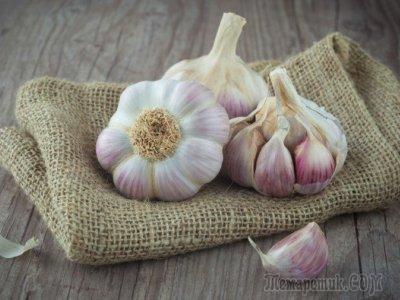
Magical and so simple garlic
About 5 thousand years ago, garlic appeared in Rome and Ancient Greece. Its main use then was medicinal - it was boiled in water, used for disinfection and for healing wounds. He, along with opium, was one of the main medicines. Before the operation, the patient drank a decoction of garlic, and they also soaked bandages on wounds. This was done so that the pain was removed, and the blood did not become infected.

And the ancients were sure that it would help strengthen the spirit and strength, cure all diseases. What is the superiority of spring (or spring garlic)? How, where and when to plant it?
What is the superiority of spring garlic
The superiority of spring (spring) garlic is that it is stored much longer. better than garlic planted in autumn, although in terms of yield it is inferior to winter garlic. These two species differ from each other in that winter garlic has a stem in the center of the head, and spring cloves fit snugly against each other.
What are its shortcomings
It should be noted that often winter garlic ripens faster and gives a greater yield. It is more suitable for use in industry and conservation. But, again, if we take into account such a factor as storage, then, of course, spring (spring) garlic will be better stored.
How does imported garlic behave?
Garlic is a plant that reproduces vegetatively. His new generations will require the same environmental conditions in which they themselves were formed. Therefore, its range is narrow. This will mean that if you bring garlic from other places, then it will not grow well in a new place. The yield of garlic brought to a new place will greatly decrease, diseases and pests will affect it more often. And he can gradually die.
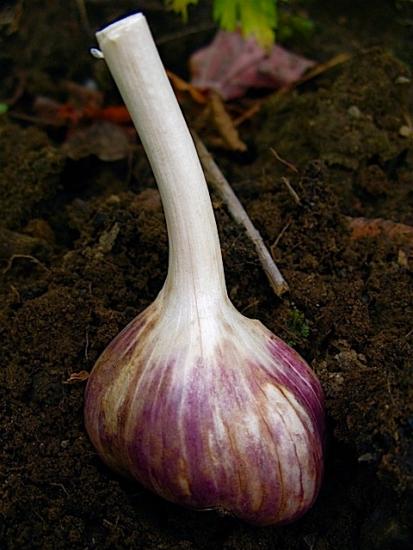
Many summer residents are wondering how to plant garlic in the spring. Since spring garlic, although not frost-resistant, is cold-resistant, some experienced agronomists who grow a large amount of garlic for sale put it in white bags for the winter (such as sugar is sold in), and bury it in the ground for one and a half spade bayonet. From above they fall asleep with a large layer of leaves and insulate with a film. Under such a fur coat, he does not freeze, but feels comfortable. If the summer resident plants a small amount of garlic, then it can be placed in the refrigerator for a couple of weeks before planting. Before planting, some keep garlic for about half an hour in a weak solution of potassium permanganate or saline (3 tablespoons per half a bucket of water).
What kind of soil is needed for garlic
The soil for spring garlic must be warm, so it is planted in the spring. Spring garlic will grow best on medium loamy soils and light loamy soils. The soil for it has been prepared since autumn. It should be rich in organic matter. If the soil is acidic, it must be limed. A suitable pH is 6.5-7.0.
When, where and how to plant garlic in spring
Garlic is planted immediately after frost, somewhere in mid-April. For planting garlic, the land where garlic or onions were planted before is not suitable; after potatoes, the land is also not suitable. It is better that cucumbers, zucchini, early White cabbage, cauliflower. The beds should be dug up and loosened.
Immediately before planting, pour the soil abundantly with a solution of table salt, at the rate of 3 tbsp. spoons in a bucket of water. Plant the garlic upside down. Approximately 1-2 centimeters deep. The distance between the teeth is 8-10 centimeters, and the distance between the beds is 15 centimeters. After germination, it is desirable to feed the garlic with ammonium sulfate, which prevents pests from spoiling the crop. It is advisable to repeat this procedure in mid-June.
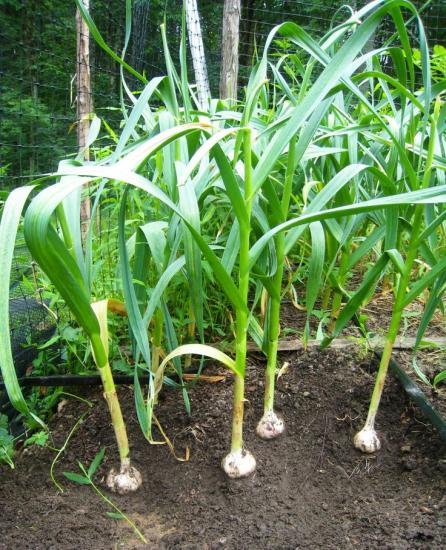
Garlic is very fond of moisture, but you should not pour it heavily in July. Let it dry a little before harvesting.
What conditions are necessary for the normal development of garlic
Garlic is a cold-resistant crop. At temperatures below 1 degree, roots begin to grow. But the optimal temperature for growth is 8-12 degrees. The ground part of the plant begins to grow at a temperature of 5 to 10 degrees above zero.
At the beginning of its growth, ardent garlic needs small positive temperatures. Otherwise, the aerial part may begin its strong growth, and the formation of the bulb will not be successful. Therefore, the sooner you plant ardent garlic, the better. During the period when the garlic cloves begin to take root, it needs moisture. If it is not enough, then the root system will dull its growth.
What are the pests of spring garlic
Garlic can be attacked by fungal diseases, neck rot, black mold, onion fly and some other pests. Garlic has good self-protection against diseases, but you need to monitor the condition of your plant yourself.
Garlic is a unique garden crop. It is capable of producing two waves of harvest during the year. Today, winter and spring varieties of the crop are being planted. This article will discuss in detail the planting of spring garlic in the spring.
At the beginning of growing any crop, you need to decide on the timing of planting its planting material. This is important point, since the growth and development of plants, as well as their fruiting, directly depends on the correct choice of the time of planting.
Spring garlic is planted in spring. If disembarkation seed carried out in open ground, then this procedure is carried out in April (end of the month) or May (beginning of the month). Planting cloves should be after the snow has completely melted from the fields. In this case, the threat of a return of frost must necessarily pass.
The best temperature to plant this subspecies of garlic is +5-6°C. Also, planting varieties of spring garlic can be carried out according to lunar calendar. According to it, gardeners determine the most favorable days for planting in April or May.
However, in order for the planting of planting material to be effective and provide the gardener with an excellent harvest in the future, it is necessary to properly prepare the teeth for placement in the ground. Also, do not forget that the land itself needs preparation.
How to prepare the soil
Many gardeners believe that planting spring garlic is easy. But this is not entirely true, because planting this crop involves not just the formation of beds and the placement of planting material in them. Here you need to properly prepare both the cloves themselves and the soil.
The landing procedure consists of the following steps:
- soil preparation;
- selection of planting material and its preparation;
- direct landing.
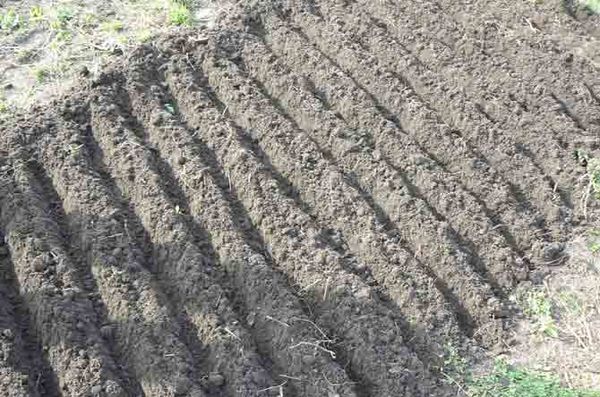
Land preparation begins with the selection of a site where garlic will grow. The main thing is to adhere to the rules of crop rotation. This culture it is not recommended to plant after carrots, onions, potatoes and garlic. The fact is that after them, microorganisms and toxins accumulate in the soil, which are necessary for the growth and development of these garden crops. But these same microorganisms and toxins interfere with the formation of bulbs. As a result, the formed heads do not have characteristic properties.
Spring varieties will give an excellent harvest when they are planted in the area where legumes, zucchini, cucumbers and tomatoes used to grow. After these plants, beneficial nutrients will remain in the ground, which will stimulate the growth and development of garlic bulbs. As a result, planting will not hurt, and caring for them will become much easier.
The choice of soil here will be the same as when growing winter varieties. Great solution will become loamy soil, which has low acidity. At the same time, moisture should not stagnate in the area chosen for garlic.
It is worth noting that determining the place of growth of this crop depends on why it is grown. To obtain soft and juicy greenery, the site should be shady. Such greens will be an excellent component of many salads. To collect large bulbs, preference should be given to sunny places in the garden.
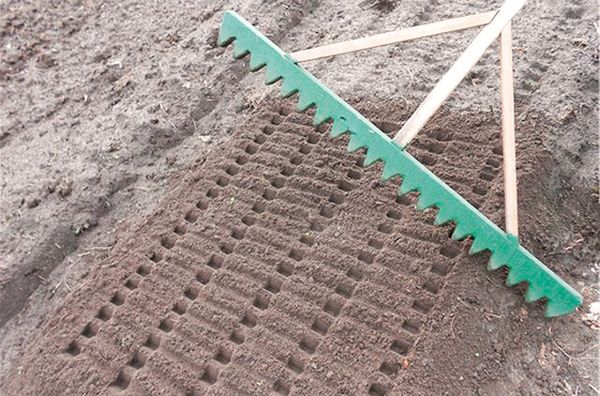
When the site has been determined, we begin to prepare it. Land preparation is carried out in autumn after the fields have been cleared of vegetation.
It is necessary to prepare the soil for planting spring varieties of garlic in the fall as follows:
- cleaning the land from organic residues;
- then it is disinfected;
- then the soil should be dug up well. The depth of digging is no more than 25 cm;
- followed by fertilization.
An important point in the autumn preparation of beds for garlic is the introduction of dressings into them. They are made by the following calculation, which is given for 1 sq.m.:
- equine / cow dung(organic) - 1 bucket;
- dolomite flour / slaked lime - 1 cup;
- potash fertilizer along with superphosphate - one tablespoon each.

Fertilizers are added to the ground depending on its type:
- for loamy soils per 1 sq.m. contribute 2 tbsp. l. superphosphate, 3-4 kg of humus, as well as 1 tsp. urea;
- for clay soils per 1 sq.m. contribute 8-10 kg of river sand, 5-6 kg of peat, 1 tsp. urea, 2 tbsp. l. superphosphate, as well as 5-6 kg of humus;
- in the presence of sandy soil per 1 sq.m. make a mixture prepared from compost (can be replaced with humus) and loamy soil (can be replaced with clay soil). The components are taken in a ratio of 1:2. In addition, it is allowed to use urea with superphosphate (taken in a ratio of 3: 1);
- for peat soil when grown in open beds per 1 sq.m. make 6 kg of humus, 1 tsp. urea, 8-10 kg of river sand, as well as 2 tbsp. l. superphosphate.
When the land has been fertilized, it is leveled. The formation of earthen clods should be avoided. After the soil has been leveled, it is watered with a solution of copper sulfate. To prepare the desired solution, 40 g of powder is dissolved in 10 liters of water.
If winter crop varieties after the above manipulations can be planted in the ground, then for spring varieties the soil should be covered with roofing felt or film. In this form, the site remains for the whole winter. This is done so that the soil does not wash out with the melting of snow. Due to leaching from the ground, all the nutrients that were obtained by the soil during its autumn feeding will leave. In this moment lies the difference in planting between spring and winter types of garlic.

Preplant treatment of teeth
A good harvest of spring garlic can only be obtained if good planting material was used for planting. Preparation of cloves for sowing should be carried out in advance. Suitable for planting garlic, which meet the following requirements:
- have large sizes. Medium and small cloves can be planted in order to obtain greenery. In this case, planting material is placed between rows of other garden crops. Such "neighbors" will protect plantings from the invasion of pests and pathogenic microflora;
- their surface is not damaged;
- there is no duality;
- on the surface of the teeth there are no traces of the beginning of the development of the disease, decay, etc.
Planting material is selected from a crop that has been stored all winter. The head from which the cloves will be removed must be solid and have intact scales.
The fact is that individual cloves during planting demonstrate a significantly lower germination intensity than those that were in the head until the last. They may not grow at all.
The garlic crop should be stored in a cool but dry place. The air temperature in the room should not rise above +7 ° C. Although it is allowed to store the heads at +17 degrees. However, in this case, the bulbs selected for planting should be transferred to a colder place a month before planting (for example, placed in the vegetable compartment of the freezer). The fact is that the frozen planting material concentrates the maximum amount useful substances. Thanks to this, it germinates faster, and also bears better fruit.
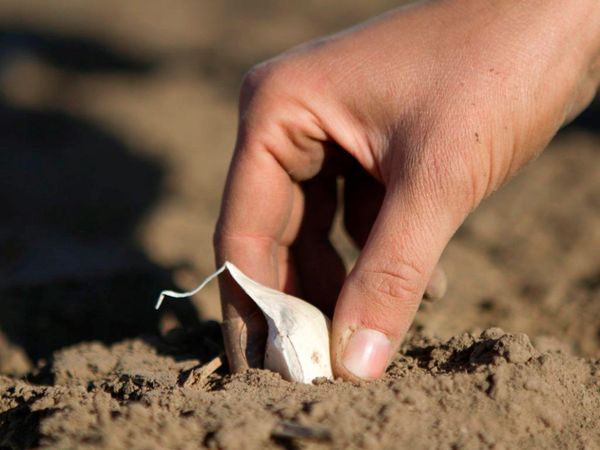
In order not to suffer with the selection of planting material from the existing last year's crop, it can be purchased in specialized stores. However, professional gardeners believe that it is better to use cloves taken from last year's crop for planting.
After the cloves have been selected, they are disinfected before direct planting. For disinfection, you can use a solution of potassium permanganate. An ash solution or tincture made from copper sulfate is also suitable. In addition to the described solutions that you can prepare with your own hands, the store sells various preparations suitable for these purposes (for example, Fundazol or Epin).
Please note that in different solutions it is necessary to keep garlic for a different period of time. For example, cloves should not be in the ash solution for more than two hours.
After that, the planting material should room temperature lie down a bit. Then the teeth are cleaned and separated from the bottom before direct landing. If the bottom remains, then it will inhibit the development of the root system of the plant.
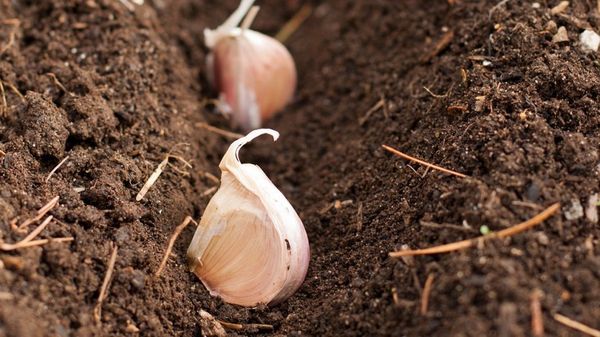
Some amateur gardeners often wonder if garlic should be soaked before planting? This procedure is possible, but it is not mandatory. The purpose of soaking in this case is disinfection, and only then the germination of planting material.
Soaking teeth as disinfection can be carried out in the following solutions:
- potassium permanganate (weak solution). Planting material should be in it for 30 minutes. After this procedure, the cloves can be immediately placed in the ground;
- copper sulfate solution (1%). In it, the seed should stay no more than one minute;
- salt solution. To prepare it, 40-50 g of salt should be diluted in 5 liters of water. Garlic should be in it for 1-2 minutes. After that, they are immediately placed for 1 minute in a solution of copper sulfate (1%). Then they are planted without washing in prepared beds;
- alkaline solution of ash. For its preparation, 400 g of ash is diluted in 2 liters of water. Then the resulting solution is boiled for 30 minutes and cooled. After that, the solution is filtered. Garlic should stay in it for 1.5-2.0 hours. When the time is up, the planting material is washed with cold boiled water and planted.
garlic care
After preparing the site and planting material, spring garlic is placed in moist soil. When planting, the distance between adjacent garlic cloves should be approximately 6-8 cm, and between rows - 20-25 cm. The garlic cloves should be located in the ground so that their upper part lies at a depth of 2 cm. Otherwise, the ripening time of the plant will increase slightly .
![]()
During the planting process, it is not recommended to press the cloves, as this will provoke a delay in the development of the root system. Therefore, we plant any spring garlic carefully. Seedlings are resistant to low temperatures. They may well form at +3°C.
It is worth noting that in the first month after planting, garlic grows very slowly. This is due to the fact that it is characterized by a weak root system. In about 3-4 weeks, the roots become strong enough to provide intensive growth of the aerial part. The teeth begin to grow actively after the growth of greenery slows down. They develop over the next month.
In order for spring garlic planted in the ground to take root, it needs proper and timely care. Without this, it is impossible to achieve a high-quality and plentiful harvest.
Agrotechnical measures, which must necessarily include the care of spring garlic, include the following:
- watering;
- soil loosening;
- introduction of fertilizers.
You can also carry out preventive spraying of plantings in order to protect them from diseases and pests.
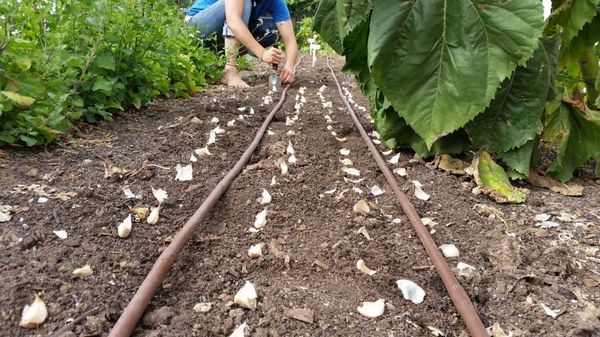
Let's consider in detail each point of care.
Watering
Active growth and development of garlic is impossible without the right organized watering. To provide plants with moisture for growing greenery, plantings are watered 3-4 times a month. This pattern persists through May, June and early July. During rainy summers, the amount of watering can be reduced. Also, watering is not carried out if the ground around the plantings is wet. Remember that excess moisture in the soil can provoke rotting of the root system, and also promotes the growth of bacteria and fungi. All this can lead to the development of diseases of both the root system and the leaves.
In July (from the second half of the month), watering is reduced and generally stopped.
loosening
This procedure is carried out the next day after watering. By this time, the earth will have had time to dry completely. Loosening is carried out in order to eliminate the crust that formed on the surface of the soil after adding water to it. This crust prevents good aeration of the earth, which negatively affects root system garlic.
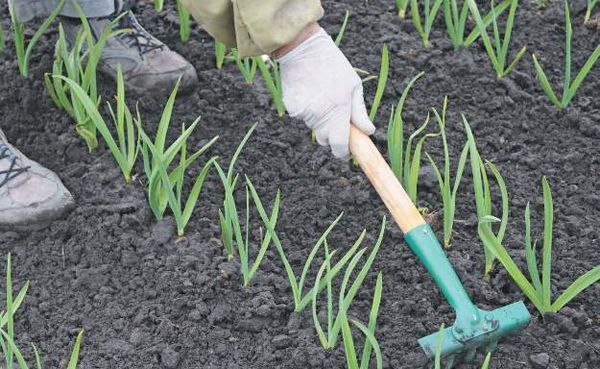
top dressing
During the growing season, spring garlic should be fed twice:
- the first time - after the appearance of the first shoots. For top dressing, wood ash is used (2 cups of the substance are diluted in 10-12 liters of water). The use of nitrogen fertilizers is allowed;
- the second time - at the moment of the beginning of the formation of heads. Here you need to use humus or other mineral fertilizers (for example, nitrophoska).
When fertilizing spring garlic, it is important not to overdo it. "Overdose" of nutrients can adversely affect the formation of bulbs. Also, cloves are able to accumulate the nitrate form of nitrogen compounds. Such compounds are toxic to humans.
With a lack of soil nutrients plants will begin to "signal" this by changing the color of the tops.
![]()
In order to get an excellent harvest of spring garlic, it is necessary to fulfill all the requirements that relate to the preparation of its planting material, beds, planting, as well as further care. Otherwise, you should not expect a quality and tasty harvest.
Video "Planting garlic in the garden in spring"
From this video you will learn how to properly plant garlic in the garden in the spring.
Svetlana














